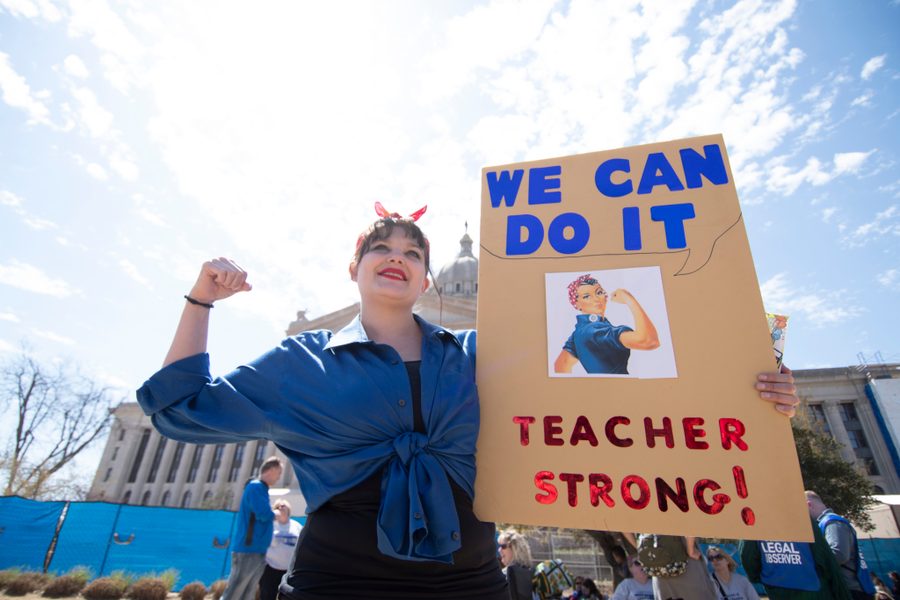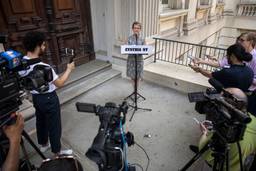
Since the 2016 election, Americans have been treated to all varieties of media profiles and literary-safari trips to the heart of coal country — like J.D. Vance’s book Hillbilly Elegy—which leave the impression that the “working class” is largely an undifferentiated mass of reactionary white men.
The West Virginia teacher’s strike provided a striking contrast to this narrative. While strikers’ red t-shirts and bandannas signaled the movement’s connection to a history of labor radicalism in the state, the strike’s demographics were also revealing. In West Virginia, as in the rest of the country, teaching is a profession dominated by women, and the strike reflected this reality. This was a women-led movement, advocating for a predominantly female rank-and-file.
Since the West Virginia strike began in late February, teachers have led militant actions in Oklahoma and Kentucky, and Arizona and Colorado could soon follow.
These actions are proving that the caricature of the Trump-voting white male worker is about as suited to represent the entire working class as Bruce Springsteen’s “Born in the USA” was suited to be Ronald Reagan’s campaign theme song. Working-class people are not predominantly white men in the extractive or manufacturing industries. Many work in the service or retail sector, are non-white, undocumented, or, due to the gender wage gap, female. A majority of the minimum-wage workforce is comprised of women.
While much has been made of the West Virginia strike’s militancy and economic demands, it is also important to understand it in the context of gender — the strike followed decades of organizing in the public sector by women.
Over the last 40 years, public and service sector unions — including in healthcare, public employment, food services and public education — have become the fastest growing unionized sectors. Collectively, they have shaped the course and composition of the labor movement. As Jennifer Klein and Eileen Boris write in Caring for America: Home Health Workers in the Shadow of the Welfare State, by the “end of the first decade of the twenty-first century, when only one in ten labored in manufacturing and half were in the public sector, women composed 45 percent of unionized workers.”
From working-class to corporate-class feminism
West Virginia teachers are admittedly not the conventional face of mainstream U.S. feminism. Much ink has been spilled on the limits of mainstream feminism, especially its reproduction of capitalist values like competition, scarcity and individualism. Putting the onus on individual women to “lean in” to the corporate workplace, the mainstream feminism advocated by figures like Facebook COO Sheryl Sandberg and Hillary Clinton teaches women that they can truly have it all, if only they behave more like men. It is becoming increasingly clear that “you can have it all” feminism only works for a select few, and corporate feminists depend on the largely invisible labor of poor women of color who clean their homes and take care of their children and elderly parents. The decline of welfare and the social safety net has only exacerbated this need, as childcare costs have soared and many women can no longer rely on the state to help balance the responsibilities of work and home.
But in the grand sweep of 20th-century feminism, an alliance with the corporate class is relatively new. Johanna Brenner has pointed out that this shift was less a matter of choice than it was a means of survival. During the 1970s and 1980s, mainstream feminism was best described as “social welfare” feminism. While far from militant or radical, it advocated for an expansion of the welfare state and called for policies like a guaranteed minimum income for single mothers and socialized childcare.
The conservative assault on the working class starting in the 1970s dealt a major blow to second wave social welfare feminism. Democrats also played a key role in its demise. In 1996, Bill Clinton’s welfare reform bill — supported by many middle-class feminists, including then-First Lady Hillary Clinton and the vast majority of Democratic congresswomen who at the time self-identified as “feminist” —closed the chapter on social welfare feminism. Democrats increasingly adopted the 1990s parlance of economic independence (versus “dependence” on the state), embracing policies that pushed single mothers into low-wage jobs while denying them access to subsidized childcare.
Meanwhile, mainstream reproductive rights organizations adopted conservative frameworks, like those proposed by the pollster Harrison Hickman, who worked for the National Abortion Rights Action League (NARAL). In 1986, Hickman suggested that NARAL frame abortion in terms of preserving a woman’s negative right to privacy, rather than a positive right to free and universally accessible abortions: ”Government intrusion … is our most effective argument…we must not stress the individual’s right to abortion, but rather, that the government does not have the right to say that abortion is never acceptable.”
It was in this climate of austerity, third-way, centrist politics, and a weakened and increasingly bureaucratic labor movement that corporate feminism came to thrive.
But this shift was, and continues to be, relentlessly contested. Even as early as the 1920s, immediately following the granting of women’s suffrage, labor feminists rejected the elitism of Alice Paul’s National Women’s Party and the Equal Rights Amendment, which they believed would do little for poor and working class women. From the welfare rights movement of the 1960s and 1970s to the Combahee River Collective to the domestic workers movement which continues to this day, working class and women of color feminists have mounted powerful challenges to the hegemonic forces of neoliberalism and global capitalism.
Today, as we saw in West Virginia, a major flashpoint for this oppositional feminism among women workers is the Right’s continued attack on the public sector. The Janus decision is just the latest chapter in a decades-long effort by the Koch-funded Right to crush unions and specifically public sector unions, which boast the largest rate of unionization in the country today.
These attacks have detrimental effects on women and African Americans, who are disproportionately represented in public-sector employment. Women of color, who represent the majority of union-represented public sector workers of color, have been hit particularly hard. While the private sector has begun to slowly recover jobs lost during the financial crisis, the public sector continues to downsize at an alarming clip.
But all is not lost. As we saw in West Virginia, the very sector that has been hardest hit by union-busting and austerity has, in recent years, demonstrated strength and resourcefulness in the face of adversity. Even before the recent wave of teacher actions, in 2012 the Chicago Teacher’s Union (CTU) strike saw teachers’ connecting their struggle for better working conditions to the larger systems of oppression affecting their students.
Organizing by nurses, a workforce that is over 90 percent female, also shows the radical potential of organizing in traditionally female occupations. In 2017, the California Nurses Association (CNA) led the fight for California’s single-payer healthcare bill, which has contributed to a groundswell of political momentum for universal healthcare.
The CNA has a long history as a militant outsider in the labor movement. In 1999, the union passed a strict nurse-to-patient law, the very first legislative victory on the issue of hospital understaffing. Its members have also been on the front lines of climate justice organizing, which they see as a public health crisis.
The limits of labor
But organized labor, even if it is led by female workers, won’t alone be enough to embolden a reenergized, leftist feminist movement today. If feminism has any chance of upending the status quo, it must also challenge the construction of work itself, and especially its function as a precondition for receiving government assistance.
Recent history makes this clear. Punitive welfare policies have played a historic role in maintaining a steady supply of low wage female workers. For example, Bill Clinton’s 1996 welfare reform bill instituted a suite of restrictions for public aid, including five-year caps on aid and mandatory work requirements that required single parents — who are overwhelmingly women — to work in public or private sector jobs in exchange for their benefits. Since passage of the bill, poverty has increased, most families in poverty do not receive welfare benefits, and millions of people live on less than $2 a day in formal income.
At the same time, restrictive immigration policies excluded immigrant and undocumented women from welfare, compelling them to accept any job they can find — typically work that is low paid, non-unionized and unsafe. In 1986, Congress passed the Immigration Reform and Control Act (IRCA), which reinstated the 1882 “public charge” law, making it illegal for immigrants to obtain visas unless they could prove that they would not require public assistance. Ten years later, welfare reform completely excluded undocumented and in some cases, legal immigrants, from receiving cash assistance.
It has been a cruel irony that the rise of “you can have it all” feminism has coincided with the decline — and near disappearance in many states in the Deep South and West — of welfare. This decline has particularly harmed single mothers. Child exclusions in the 1996 welfare bill, for instance, gave states the option to establish caps on financial assistance if the recipient had more children while receiving aid.
As Sharon Smith writes in the International Socialist Review, these caps have led to disastrous consequences in states like New Jersey, where cash assistance has not increased in 29 years. “If a woman has an additional child while already receiving welfare payments,” Smith observes, “her cash assistance drops from $424 to $322 per month. Eight in ten New Jersey children living in poverty receive no public cash assistance.”
With marriage becoming more and more limited to the middle and upper classes, and with singles (especially single mothers) locked out from state assistance, the need has never been greater for a feminist politics that rethinks basic family and economic structures. More than any other issue, women’s liberation rests on whether we will socialize the cost of caring for individuals and families.
Toward new feminist futures
Canada’s Leap manifesto offers a view into what such a societal change might look like in practice. Calling for a political economy centered around “caring for the earth and one another,” the manifesto seeks to expand the “sectors of our economy that are already low carbon: caregiving, teaching, social work, the arts and public-interest media.” In addition to investing in a care work economy, the platform — which was approved by representatives from Canada’s various social movements — calls for a universal basic income and nationalized childcare. These could all serve as short-term demands for a renewed feminism in the United States.
But with a conservative Supreme Court majority and a misogynist union-buster-in-chief, we can’t afford to be naive about the challenges ahead. It is all but an inevitability that right-to-work across the entire public sector will be enacted in the near future, eviscerating not only the most unionized sector in the country, but one dominated by women and people of color.
As the Women’s March and International Women’s Strike demonstrate, Donald Trump’s presidency has inspired a mass desire among women to resist. But there are still major barriers to systemic change. Mainstream reproductive and women’s rights organizations like the National Organization for Women and NARAL employ a Washington insider strategy of lobbying and electoral campaigns. This approach is wholly inadequate in the face of mounting inequality and conservative attacks on women’s basic rights. With some notable exceptions like the Working Families Party, we’ve yet to see the proliferation of independent, grassroots feminist organizations or a return to the demands of social welfare feminism, including universal childcare and free and on-demand abortions.
And yet, this moment feels different. While the full impact of the #MeToo movement remains to be seen, it has unleashed a wave of activism against sexual harassment, assault, and the gender pay gap — issues that speak to the everyday lived experience of the vast majority of women.
Meanwhile, in the weeks following the West Virginia strike, teachers across the country have risen up to demand fair pay and dignity on the job. In struggles led predominantly by women workers — whose labor has historically been both underpaid and undervalued — we’re seeing the return of efforts to build meaningful alternatives to corporate feminism. As the 1930s labor regime falls apart, and the center increasingly cannot hold, perhaps there is no vanguard better suited to that task.







